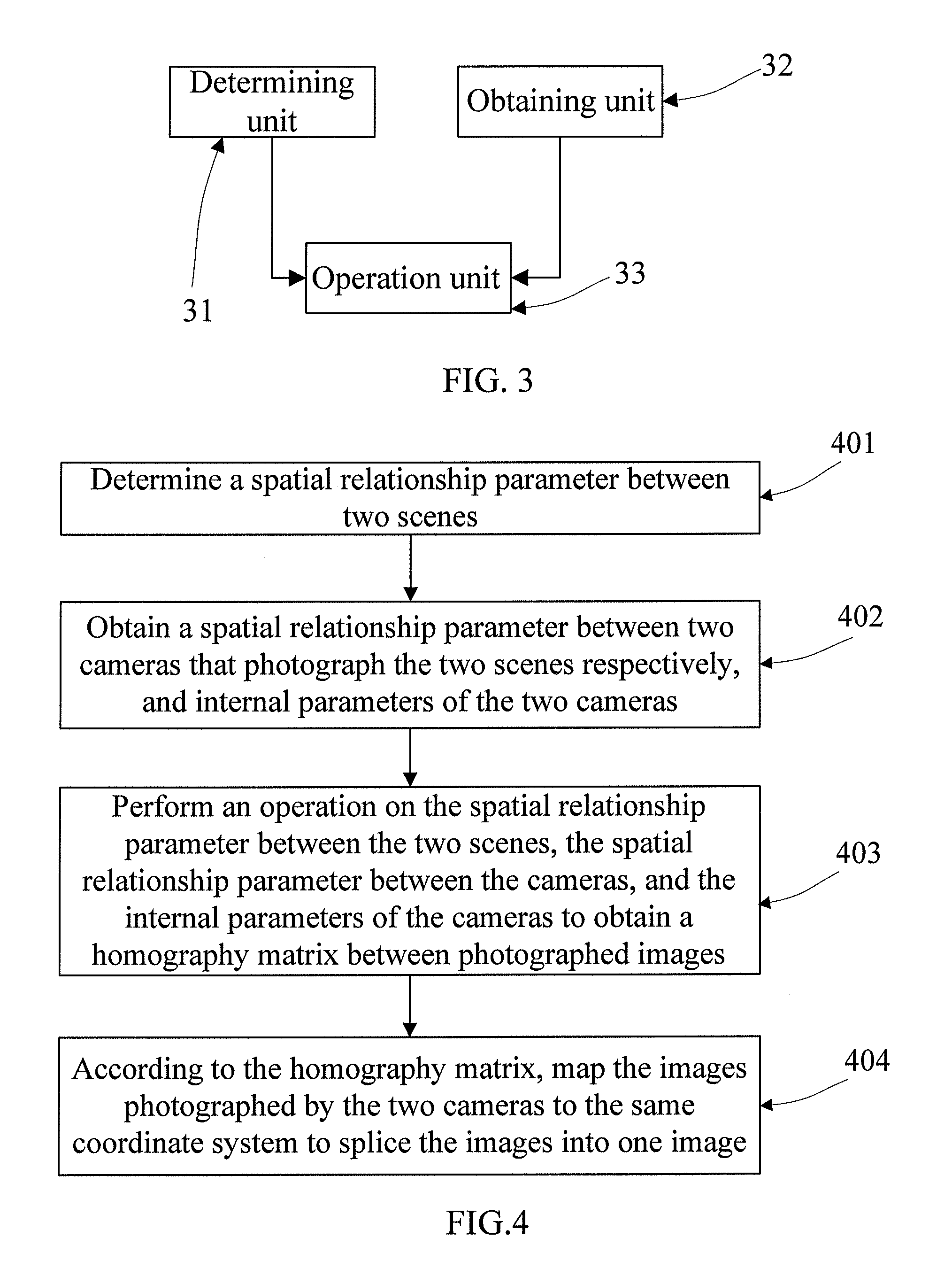Image splicing method and apparatus
a splicing method and image technology, applied in the field of image processing technologies, can solve problems such as serious distortion of the constructed seamless wide-angle imag
- Summary
- Abstract
- Description
- Claims
- Application Information
AI Technical Summary
Benefits of technology
Problems solved by technology
Method used
Image
Examples
embodiment 1
[0047]If two cameras photograph two scenes respectively to obtain images of the two scenes, or one camera photographs two scenes separately to obtain images of the two scenes, in order to splice the obtained images of the two scenes together, a homography matrix between two images needs to be calculated. A first embodiment of the present invention provides a method for calculating a homography matrix between cameras. As shown in FIG. 2, the method includes:
[0048]201: Determine a spatial relationship parameter between two scenes. The spatial relationship parameter may be represented by a function. It is assumed that one scene is P1 and the other scene is P2, and then the spatial relationship parameter may be represented by P2=f(P1).
[0049]202: Obtain a spatial relationship parameter between two cameras that photograph the two scenes respectively, and internal parameters of the two cameras. The spatial relationship parameter may also referred to as an external parameter and is used to ...
embodiment 2
[0067]Application of this embodiment of the present invention is described in the following by taking a photographed image of a large checkerboard as an example. First, a large checkerboard as shown in FIG. 6 is made. There are two areas that are to be photographed and are enclosed by a line 1 and a line 2 in the large checkerboard. Sizes of these two areas to be photographed may be adjusted according to an actual requirement. A black check or a white check in the foregoing checkerboard is generally a square or a rectangle with a known size. Sizes of checks in the checkerboard are known, and therefore, a position relationship (that is, a spatial relationship parameter between two scenes) of a three-dimensional space of the two areas to be photographed may be known or calculated out. That is to say, choosing any pair of checks in an area to be photographed, a relative position relationship between them is known or may be calculated out.
[0068]In addition, a left camera and a right cam...
embodiment 3
[0091]In this embodiment, it is assumed that P1 and P2 are two points in two scenes, and a spatial position relationship between the two scenes is P2=f (P)=P1+b. And it is assumed that K, K′ a re internal parameter matrixes of a left camera and a right camera respectively, [R1 t1], [R2 t2] are external parameters (which may together represent a spatial relationship between cameras) of the left camera and the right camera respectively, and [R t] a re a rotation matrix and a translation vector of the right camera relative to the left camera.
[0092]It is assumed that coordinates of P1 and P2 are p1 and p2 in their respective corresponding images, and P1 and P2 correspond to points and Pc1 and Pc2 in a camera coordinate system, then:
{ P1=R1Pc1+t1P2=R2Pc2+t2
[0093]A relative position relationship between cameras does not change, and therefore, H does not change either,
[0094]then: P2=R2Pc2+t2=R1Pc1+t1+b, accordingly, R2s2Pc2+t2=R1s1Pc1+t1+b , where s1 and s2 represent depths of Pc1 and Pc2....
PUM
 Login to View More
Login to View More Abstract
Description
Claims
Application Information
 Login to View More
Login to View More - R&D
- Intellectual Property
- Life Sciences
- Materials
- Tech Scout
- Unparalleled Data Quality
- Higher Quality Content
- 60% Fewer Hallucinations
Browse by: Latest US Patents, China's latest patents, Technical Efficacy Thesaurus, Application Domain, Technology Topic, Popular Technical Reports.
© 2025 PatSnap. All rights reserved.Legal|Privacy policy|Modern Slavery Act Transparency Statement|Sitemap|About US| Contact US: help@patsnap.com



